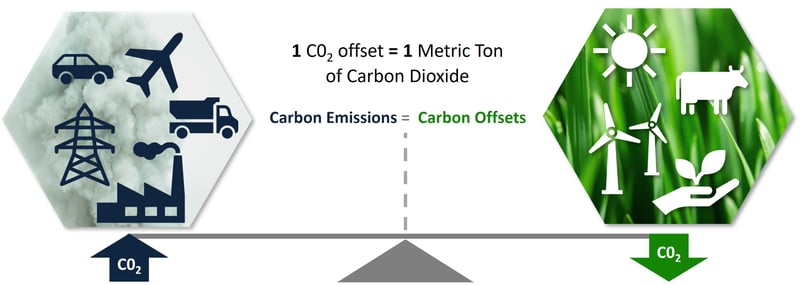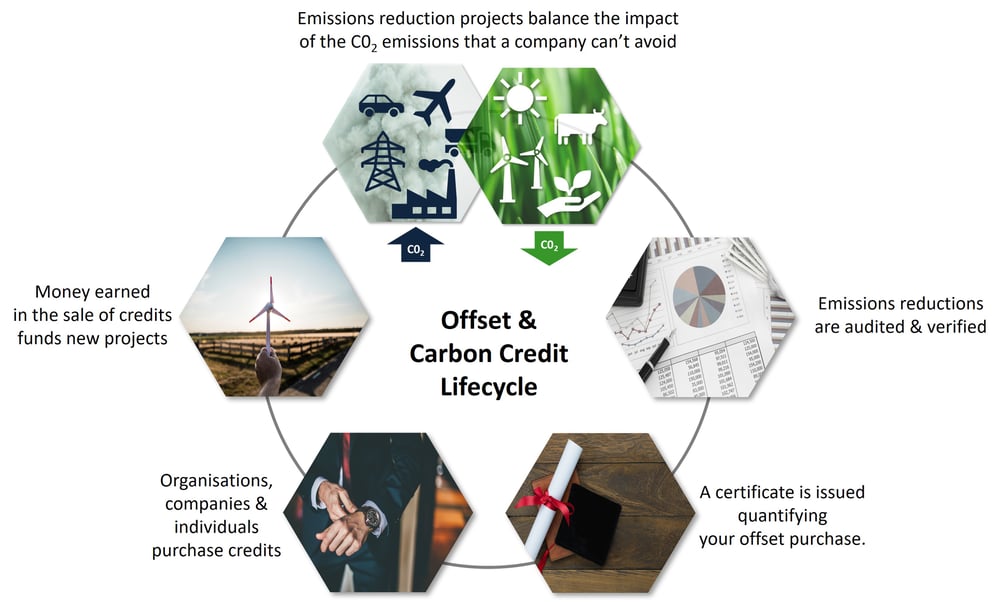Carbon Off-sets!
What are they and how do they work?
In recent times we have seen alarming evidence and growing support behind the movement to pressure Governments into climate action. Evidence has come at a pretty high cost considering recent and increasingly devastating climate-linked disasters in which Australia has not been immune (the 2020 bush fires are still pretty fresh in everyone's mind). Adding weight and concern is the recent United Nations report that painted a pretty bleak picture, with the best-case scenario for climate change almost out of reach.
|
Emissions Gap Report 2020: An Inflection Point Despite a dip in greenhouse gas emissions from the COVID-19 economic slowdown, the world is still heading for a catastrophic temperature rise above 3°C this century – far beyond the goals of the Paris Agreement. |
|
This has been a wakeup call for a lot of people and certainly for business to tackle climate change head on with a focus on reducing greenhouse gas emissions through technology and renewable energy. One of the keyways that business can contribute to sustainable development and reduce emissions is through the purchase carbon offsets or investing in projects that create carbon credits.
So, what are Carbon Offsets and Carbon Credits?
Carbon Offsets
With a carbon offset, a business, government, or an individual can pay someone else to cut or remove a given quantity of greenhouse gases from the atmosphere. This can take the form of helping developing countries buy cleaner-burning cookstoves that reduce deforestation for firewood or investing in clean energy such as solar or a wind turbine generator to displace fossil fuels on the power grid.

Critically, the reduction in GHG emissions from these projects counts toward the balance of the business, person or government buying the offset, rather than the people installing the project or the place where it’s built.
What’s more, buying offsets is something anyone can do if they have the money. And unlike policies like a carbon tax, an offset is directly connected to a specific quantity of greenhouse gas emissions, at least on paper.
A carbon offset essentially is a certificate that represents the reduction of one metric ton of carbon dioxide emissions from the atmosphere, the principal measurement of climate change.
Buying carbon offsets may seem like a lazy approach to a climate solution, however they can play an extremely important roll to all of us.
Whilst businesses and individuals may do everything they can to reduce greenhouse emissions and our carbon footprint, it’s unlikely that just by doing this we would get to net zero under a business-as-usual scenario.
This is where purchasing carbon offsets can reduce the overall amount of carbon you would be accountable for!
e.g. A businesses or individual purchases carbon offsets for recent air travel or buys carbon offsets to help fund a specific range of carbon projects.
Carbon Credits
To explain how Carbon Credits work we will use an example. Noting the following is for illustrative purposes only.

Under a business-as-usual scenario, a manufacturing facility emits 120,000 tons of CO2-e (Greenhouse Gas Emissions) per annum. The manufacturer has a goal of being gold standard and net zero by investing in technology to find ways to produce its products with limited amount of emissions; this is a long-term goal which may take years. However for the manufacturer to achieve its short-term commitments, it will need to participate in the offset program. By purchasing carbon offsets the manufacturer can bring its total accountable emissions down to its short-term mandate of 100,000 tons of Co2-e.
At the same time a large landowner (which could be in Australia or overseas) that has a parcel of land with an identified potential to be monetised for timber mills may agree to forgo aggressive timber harvesting on this parcel of land in perpetuity, the landowner can receive Carbon Credits and then sell offset credits to the manufacturer. The landowner can generate cashflow and the manufacturer can meet its short-term goals.
The Landowner will need to go through various compliance hoops and have the project audited and registered within the offsetting scheme.
From the example above there are two areas where Carbon Credits can be generated:
- By the manufacturer investing in technology to otherwise reduce GHG emissions within its production process, and
- The landowner forgoing the opportunity to monetise the use of land in favour of creating offset credits they can then on sell.
So if you develop a project that reduces carbon dioxide emissions, every ton of emissions reduced results in the creation of one carbon credit. Project developers can then sell these credits as offsets to finance their projects. There are hundreds of different project types circulating around now.
Other project examples are a dairy farm can install an anaerobic digester to capture and destroy methane that would otherwise be released when animal manure decomposes. However, such anaerobic digester projects are typically expensive to install and maintain. In order to finance the construction and operation of a digester project, a dairy farm can sell the emission reductions in the form of carbon offsets.
Where to Get Your Carbon Offsets!
Within Australian there are Carbon Retailers starting to appear which allow businesses and individuals to purchase voluntary carbon offsets.
A carbon retailer essentially purchases Carbon Credits in bulk at wholesale rates. These credits are then broken-down into different portions depending on the service required, e.g. a retailer purchases 100 credits in bulk and sells a portion of those credits to a business that only needs to offset air travel by 20 credits.
The carbon price is based on demand, and demand is strengthening into a booming market. The carbon market essentially has two types of offset within the trading schemes, broadly the categories are: voluntary and compliance.
Voluntary offsets are the ones people and companies buy at their own discretion. Compliance offsets are used to meet legally binding caps on carbon in schemes like the European Union’s Emissions Trading System
The Taskforce on Scaling Voluntary Carbon Market estimates that voluntary offsets need to grow 15-fold by 2030 and 100-fold by 2050 in order to meet the Paris Agreement ambition. And now, as 21% of the world's largest 2,000 public companies, accounting for sales of almost $14 trillion, have set net zero commitments, the way for carbon offset pricing will only go UP.
If you are interested in purchasing any carbon offsets we suggest doing some research. Guidance can be found on the Australian Energy Regulator Website.
Examples of how carbon offsets are generated.
Emission reduction projects reduce the amount of greenhouse gases in the atmosphere in one of three ways:

Siecap is accredited to provide, impartial inventory auditing services, in accordance with ISO14065 and the GHG Protocol, Corporate Accounting and Reporting Standard:
- ISO14064-1, design, develop, manage and report on an organisation’s GHG inventory.
- ISO14064-2, Quantify, monitor and report emission reduction and removal enhancement on GHG projects or project based activities.
- ISO14064-3, Specification with guidance for use for the verification and validation of GHG statements
Related Articles:
References:
- Australian Energy Regulator Website. [Online] http://www.cleanenergyregulator.gov.au/Infohub/Markets/Pages/Buying-ACCUs.aspx
- Ecosystem Marketplace, Insights Brief, May 2021. [Online] https://www.ecosystemmarketplace.com/carbon-markets/
- Taskforce on Scaling Voluntary Carbon Market. [Online] https://www.iif.com/tsvcm
- UNEP - Emissions Gap Report 2020. [Online] https://www.unep.org/emissions-gap-report-2020
Contact us to enquire more about how to reduce your carbon footprint or how one of our services can assist your organisation reduce cost and emissions.



